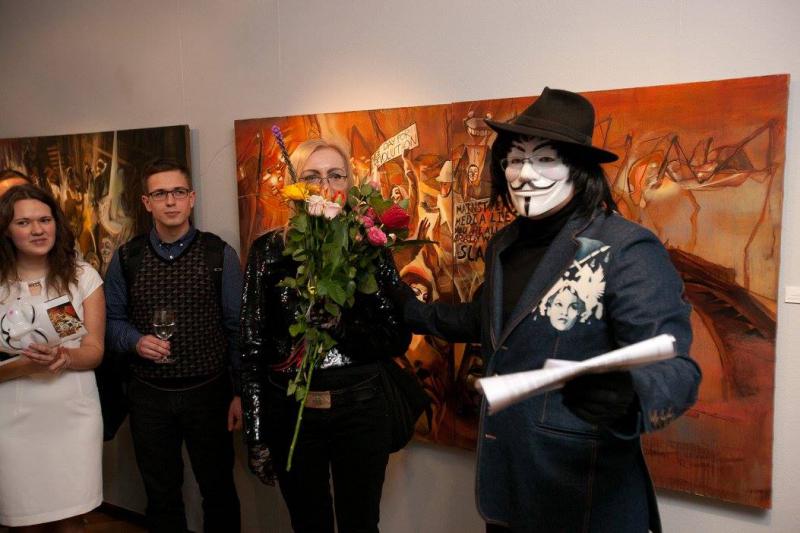FLASHES OF FERTILE THOUGHTS ON THE “ANONYMOUS RESERVATUS” – PAINTED BY ILZE JAUNBERG
http://lampisterie.ilcannocchiale.it/post/2807137.html
(translation Sarah Lane)
Anonymous: emblematic mask and multiplied icon,
Anonymous: mask showing rebellion,
Anonymous: de-identitied and sexless mask,
Anonymous: unemotionalised and de-ageing mask,
Anonymous: mask of de-ethnicised irrelevance,
Anonymous: stereotyped and globalising mask,
Anonymous: right you are, if you think so and each to his own mask,
Anonymous: unmistakeable mask in search of an author.
The Anonymous mask, which appears in variously crowded depictions in Ilze Jaunberga’s paintings, is characterialised by Goyaesque chromatic dramatisations and iconic Tintorettesque ensembles that are allusive and reserved rather than assertive and forceful. Since it absorbs the bodies of those who wear it, it makes them appear as individuals belonging to a single kind that is de-featured, de-ethnicised, de-aged and de-identitied thus becoming trans-sexual, trans-generational and trans-national.
It’s the same mask as worn by the character in the film “V for Vendetta” adapted from the cartoon of the same name and later chosen as an identifying icon diffused by the Indgnatos movement which originated in Spain in 2011. The Latvian artist didn’t however intend to convey the idea of Vendetta, but rather she meant to emblemise the idea of rebellion against the illiberal officialised powers and the neo-sovietism of Putin: globalising interclassism and making each individual’s ethnicity, age and sex conform.
Jaunberga adopted the mask as a recurrent icon in 2012, with a painting entitled “Critical Temperature” (the main draw at an exhibition in Riga) which was permeated by the idea of an increase in tension in social and political relations worldwide. The idea is to signal the anonymity of wearing a shared mask by those who intend to express their rebellion, and – masked – control it.
It represents an impression of the features of Guy Fawkes, the English dynamite-brandishing terrorist before his time and Catholic plotter, who failed in his assassin attempt of the king and was slaughtered at the age of 36 in Westminster on 13 April 1606 (James I was on the throne and it was during the lifetime of Shakespeare 1564-1616). cf Wikipedia
Although each of the canvases painted for the installation entitled “Anonymous Reservatus” – which were first displayed at a preview at Cà Ròiss in Venice during the 2014 Carnival – is an autonomous composition, they were all conceived as fragments of a single image to make up a large-scale fresco in-progress. They feature a recurrent iconic design and are characterised by formal constants, such as the Tintorettesque crowding of figures, the overall use of colour which includes references to certain dramatic glooms typical of Goya, and the poetical and ethical nature which ideologises them and gives them substance.
The Latvian artist used her emotions and instincts to paint each one of them, letting her thoughts lead her hand, free from the slightest desire to reproduce a reality of people, things and places that can be easily recognised. Her hand can be considered the “window on her mind” (Kant), the “hand that works” as Hegel thematised (taken up by Marx) and a praiseworthy hand, to paraphrase the words of Henri Focillon, who wrote a book published in 1939 under the title “In praise of hands”.
Painting the works, she didn’t aim for “vedutismo”, or sights seen by herself and others, but she painted to transfigure and iconise her thoughts whilst seeing. Through the paintings she traced a mental journey which is notable for its highly personal and vivid trademarks.
She painted to convey the collective carnivalesque nature of Venice, disambiguating it after having experienced and documented it in immobility, for her future memories, by taking photographs.
Painting in this way, the subjective carnivalesque simil-Venetian of the fifteen/seventeen hundreds is simulated repeatedly to tell the nothings of self-promoters who occasionally mask, in a serene Venetian way, their individuality that is wholly, yet alternatively and in every moment of the day, gratified by sterile friendly relationships scattered with flimsy emotions that are conventional and sometimes shared.
Ilze Jaunberga as an artist takes constant care to favour symbolisation and emblemisation and these are both predominant in her paintings while sweetened decoration and peaceful illustrations are considered discriminative. (www.ilzejaunberga.com)
Ilze Jaunberga nella Birkenfelds Galerija a Riga in Lettonia omaggiata con fiori durante il vernissage della sua esposizione personale.
NOTE – Every year on 5 November, the UK celebrates the fact that King James I was saved during the so-called Gunpowder Plot. The same event is recalled by English teachers in Latvian elementary schools with the rhyme “Remember, remember…” about the Anonymous Guy Fawkes and his failed plot.
The title Anonymous Reservatus is thus intended to mean Controlled Anonymity, rebellious but not vengeful – a shared or shareable anonymity that results in being more participated and globalised, as each can decide where, when and how to display or spread their rebellion.

